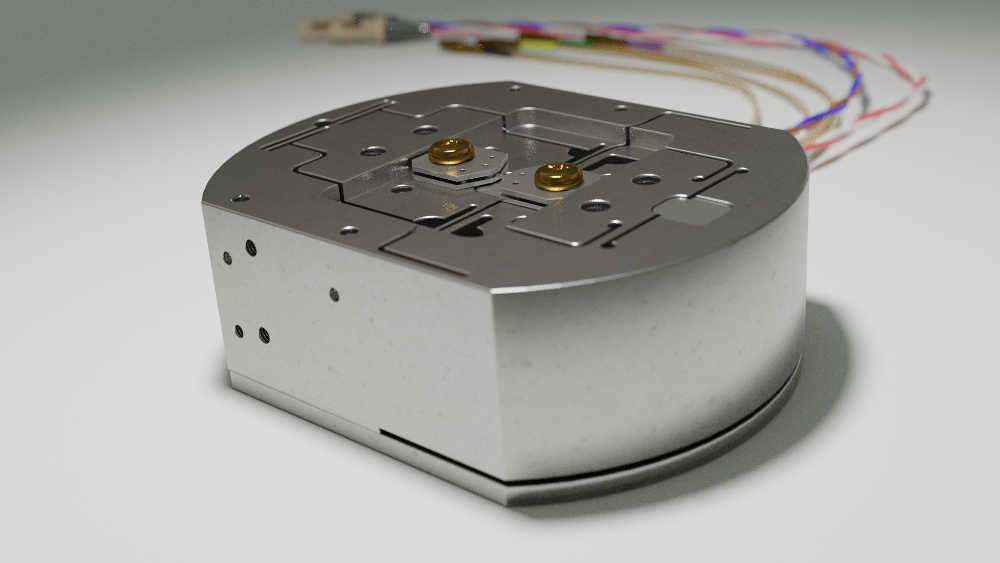The UC200 allows samples to be tuned using stress & strain while independent force and displacement measurements are carried out. This provides a wealth of information about the viability of the sample within the cryostat and its mechanical properties at different temperatures.
Product Overview

· Achieve unprecedented control of your samples by monitoring stress and strain simultaneously
· Small footprint of 47 mm diameter (~1.85 inch)
· Vacuum compatible, and can operate below 1 K and at high magnetic field
· Compatible with a wide range of experimental probes
Product Specifications
| Specifications | UC200 | |
|---|---|---|
| Size | Diameter Height (excluding sample bolts) Width |
47 mm 16 mm 37 mm |
| Applied displacement at zero load (± 10%) | Maximum displacement at 300K Maximum displacement at 4K |
±15 μm (-20 to +120 V) ±9 μm (-200 to +200 V) |
| Applied force at high load (± 10%) | Maximum force at 300K Maximum force at 4K |
±50 N (-20 to +120 V) ±35 N (-200 to +200 V) |
| Operating Conditions | Operating Temperature Magnetic field |
Below 300mK to 325K 0T to >30T |
| Feedback sensors | Both force and displacement | |
| Power supply | 2-channel, sink/source +/-200V | RP100 |
Applications

A cartoon showing some stress-strain curves of a material above and below its structural transition temperature. A structural transition will be evident by a pronounced change in the gradient of the stress strain curve. This can be monitored in real time using the UC200.
Diagnostic benefits and measuring the mechanical properties of a sample
Being able to measure stress as well as strain at the same time brings many advantages. Instead of being left scratching your head, wondering whether you need to disregard an entire set of experimental date, you will be able to detect clear indications of critical problems as soon as they happen. For example, if you are subjecting a sample to extreme strains, you will clearly see in your data if your glue is slipping, if sample is deforming plastically or if it has broken rather than trying to rationalise what has happened later from confusing probe data.
Aside from the diagnostic benefits described above, measuring both stress and strain allows you to characterise the mechanical properties of your sample at cryogenic temperature in a way that simply has not been possible previously. This opens up the opportunity to see new physical phenomena that have only been indirectly observed before. For example, it will be possible to see sharp changes in gradient of your stress versus strain graphs as your materials moves through structural transitions.
Compatible with a wide range of probes
As well monitoring the mechanical properties as discussed above, the cell is compatible with a wide range of other experimental probes including Electrical transport, AC magnetic susceptibility, NMR, Raman spectroscopy, x-ray scattering, scanning probe microscopy, optical imaging and many others.

Four 50 micron gold wires have been attached to the sample so that resistivity measurements can be conducted during straining. Our WP100 wiring platform positions gold contact pads closer to make these kinds of electronic measurements easier.
Multiplexer

The UC200 has two sensors, for force and displacement, and output of each of these is a capacitance, which must be read by a capacitance bridge. This is why each UC200 is provided with a MP240 multiplexer as standard so that both sensors can be read using a single capacitance bridge.
Customer Requirements

For best results we recommend that customers use the cells with the following equipment;
- A Razorbill Instruments RP100 power supply is compatible with the UC200 as well as our other range of stress and strain cells. This power supply can supply low-noise four quadrant, sink/source voltages of ±200V.
- Use of the feedback sensors requires the detection of an approximately 3 pF capacitance. A high quality, low-cost option is the Keysight E4980AL (20 Hz to 300 kHz). For higher resolution, stability, the more expensive Andeen-Hagerling model 2550A (or similar) can be used, although this will be unnecessary most users. For dilution fridge users with very low cooling power, we recommend the Andeen-Hagerling options as these users may be sensitive to the tiny heat load the Keysight E4980AL produces.
- Please note that although there are two sensors that each provide a force or displacement output as a capacitance signal, only one capacitance bridge is required as a low noise coaxial multiplexer is included with your purchase of a UC200 cell.
- Suitable wiring and feedthroughs into the cryostat or vacuum chamber. The FC100 requires 4x drive voltage lines to drive the cell and 4x coax cables for the sensor. Razorbill Instruments can provide kits for adding suitable cabling and feedthroughs to a range of commercial cryostats. Please contact us for more information.




